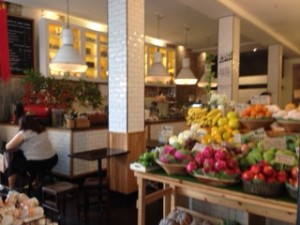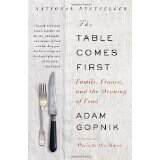MAD Syd and Noma: Tomorrow’s Meal?
A few months ago, Rene Redzepi opened his pop-up Noma restaurant at Barangaroo, Sydney. Very expensive and sold out in minutes.
On 3 April 2016 at the Sydney Opera House, there was a symposium with a line-up of speakers: Rene Redzepi, David Chang, Kylie Kwong, Massimo Bottura, Neil Perry, Clayton Donovan, Rebecca Huntley, Chodo Givera and Gayle Quarmby.
The most inspiring speakers were: Kylie Kwong talking about her Chinese heritage, Massimo Bottura talking about Osteria Francescana at Modena which feeds the homeless. Chodo Givera who started her own mushroom business in Zimbabwe. Gayle Quarmby who along with her husband runs Outback Pride, an indigenous produce business.
Firstly, Tomorrow’s Meal could and ideally should include indigenous foods.
Here’s a quote from John Newton’s blog:
After all, it was founder Rene Redzepi’s musing on what was lacking in that cuisine in 2010, and he was specifically talking about native ingredients – ‘…it’s a poor culture if it doesn’t have a true, unique expression that can only be represent right there at the place’ – that led him to return and to open his pop-up Noma to end his sojourn with MadSyd.
There has been a lot of negative commentary about the Noma pop-up dinner in Sydney: too expensive, food was too technical, tizzied and tweezered, which perhaps might give rise to questioning the concept of hospitality – making the customer feel at home.
Lee Tulloch, in a Luxe Nomad column (7/11/15) wrote that she wants to be delighted when she eats at a restaurant. She suggests that one should leave one’s expectations at the door, and go with an open mind.
Terry Durack reviewed the Noma pop-up and gave it a good mark, but there were “The Worst Bits”: no bread, no meat, no red wine. Here’s the final paragraph in his review:
We already have brilliant and inspirational chefs in Australia working with indigenous produce, such as Ben Shewry of Melbourne’s Attica and Jock Zonfrillo at Adelaide’s Orana, but Noma Australia will have its own far-reaching effect; giving us the confidence to make our own, our own.
Why do we need foreign chefs like Jean-Paul Bruneteau and Rene Redzepi to tell Australia about its own indigenous foods? Maybe after about 200 years we ought to have shown some appreciation and educated ourselves about the native foods available, and how to cook them. Can’t be that hard, can it? More about that in another blog piece.
Secondly, it seems that the most enthusiastic speakers were also those who addressed the issue of Tomorrow’s Meal from a more basic point of view: feeding less fortunate communities.
Massimo Bottura is a celebrity chef who used to run a famous restaurant in Modena, Italy doing molecular gastronomy. He changed his mind and addressed the issue of food waste and hunger by opening Refettorio Ambrosiano, in a church refectory. For more information have a look at this: osteriafrancescana.it /food-for-soul.pdf
He said two things which caught people’s attention: “Cooking is a call to act”, and “We need more chefs who know about the soil and farmers who know more about food.” I couldn’t agree more – there’s another issue here: some people don’t know where their food comes from.
Chido Givera is a farmer and food activist from Zimbabwe. She runs a small business growing mushrooms. It helped her out of enslavement and ongoing poverty, and helps other women learn agriculture and business skills.
Kylie Kwong spoke about her Chinese background and her increasing interest in indigenous foods. She was accompanied by Gayle Quarmby, a supplier of indigenous foods – Outback Pride. They were both enthusiastic that indigenous foods would play a part in Tomorrow’s Meal.
Community food organisations tend to focus the mind to somewhere near you.
Kylie Kwong is involved with Two Good Food, along with Matt Moran and Neil Perry, which supplies lunch food to corporates, and gives some of the profit to those in need. She’s is also involved with local community gardens which as at the Wayside Chapel, and St Canice’s, Rushcutters Bay.
Here’s the Two Good website: http://www.twogood.com.au/#intro
Indira Naidoo, who has a balcony garden at Potts Point, promotes balcony and community gardens eg. Wayside Chapel, Potts Point. Here’s some more information: http://theediblebalcony.com.au/about.html
Recently (Thurs 14 April 2016) there was a dinner run by IOOSK (Inside Out Organic Soup Kitchen) dinner at St Canice’s rooftop kitchen garden. It’s a soup kitchen, but now an outreach cooking program for young parents. The idea is that it “Heals from the inside out.”
The entertainment was wonderful. Darren Percival seemed at first as if he was checking the audio, but was actually starting the entertainment, encouraging the audience to sing along.
Tilly Hinton is the Nourish Talks organiser.
Costa Georgiadis, the “King of Soil” and ABC Gardening Australia presenter, talked enthusiastically about his favourite topic.
The Bright Catering company provided beautiful vegetarian food, and Krinklewood provided the wines.
My friends and I really enjoyed the evening, and were happy to have some of the ticket price being donated to community groups which help people. And we can’t wait for the next one.
Perhaps, for Tomorrow’s Meal, it might have been good idea if Noma and Momofuku had donated some of their profits to charities.

 sociological and consumer point of view, including snobbery and food fads.
sociological and consumer point of view, including snobbery and food fads.